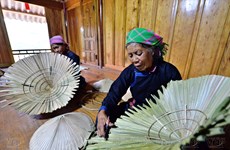Fishermen prepare for four days of whale worship
The association said that about 80
percent of Vietnamese garment makers had received orders that would see
them through to the end of the year.
The annual Nghinh Ong or Whale Worship
Festival, a traditional festival for fishermen, will begin on Oct. 2 in
HCM City ’s only coastal district, Can Gio.
The manager of the district’s Department of Culture and Information, Nguyen Van Tot, said that the four-day festival would open at several venues at 8am in Can Thanh Town.
On the third day, a ceremonial offering will be made by village elders in the traditional manner to show people’s gratitude to the whale and commemorate those fishermen that had died at sea.
The offering, one of the highlights of the entire festival, will feature a palanquin procession from Lang Ong Thuy Tuong, or the Whale Tomb, to the sea and a whale welcome ceremony involving a fleet of 500 boats.
The rituals will be followed by festivities to celebrate the community’s well-being and prosperity last year. This will involve several folk performances like playing football on stilts, unicorn dances, tying crabs and wrestling, with the highlight being a performance of human chess.
La Quoc Khanh, deputy director of the city’s Department of Culture, Sports and Tourism, said the district is hoping to turn the Nghing Ong Festival into a major tourist event and develop local tourism by focusing on sights, culture and history, he said.
“Can Gio has potential to develop a wide range of eco-tourism. We aim to develop the district into an ideal weekend destination for city residents,” he said.
A road connecting the city with the district, the first of its kind, would be completed this year, he said.
The districts lacks enough facilities or services to host a large number of international tourists but is likely to welcome around 3,000 visitors every day.
The HCM City Youth&Children Outdoor Activities Centre at the district’s Long Hoa Commune will offer an exploratory two-day tour of the Can Gio mangrove forest at a moderate 413,000 VND.
Can Gio District, situated around 50km to the southeast of downtown HCM City, spreads over 70,421 ha. Well over half of it is occupied by forests, 22,850 ha by canals and rivers, and the most of the rest by aquaculture farmers, orchards and salt fields.
The mangrove forest here was recognised as Vietnam’s first biosphere reserve by UNESCO in 2000, joining a global network of 368 others in 91 nations./.
The manager of the district’s Department of Culture and Information, Nguyen Van Tot, said that the four-day festival would open at several venues at 8am in Can Thanh Town.
On the third day, a ceremonial offering will be made by village elders in the traditional manner to show people’s gratitude to the whale and commemorate those fishermen that had died at sea.
The offering, one of the highlights of the entire festival, will feature a palanquin procession from Lang Ong Thuy Tuong, or the Whale Tomb, to the sea and a whale welcome ceremony involving a fleet of 500 boats.
The rituals will be followed by festivities to celebrate the community’s well-being and prosperity last year. This will involve several folk performances like playing football on stilts, unicorn dances, tying crabs and wrestling, with the highlight being a performance of human chess.
La Quoc Khanh, deputy director of the city’s Department of Culture, Sports and Tourism, said the district is hoping to turn the Nghing Ong Festival into a major tourist event and develop local tourism by focusing on sights, culture and history, he said.
“Can Gio has potential to develop a wide range of eco-tourism. We aim to develop the district into an ideal weekend destination for city residents,” he said.
A road connecting the city with the district, the first of its kind, would be completed this year, he said.
The districts lacks enough facilities or services to host a large number of international tourists but is likely to welcome around 3,000 visitors every day.
The HCM City Youth&Children Outdoor Activities Centre at the district’s Long Hoa Commune will offer an exploratory two-day tour of the Can Gio mangrove forest at a moderate 413,000 VND.
Can Gio District, situated around 50km to the southeast of downtown HCM City, spreads over 70,421 ha. Well over half of it is occupied by forests, 22,850 ha by canals and rivers, and the most of the rest by aquaculture farmers, orchards and salt fields.
The mangrove forest here was recognised as Vietnam’s first biosphere reserve by UNESCO in 2000, joining a global network of 368 others in 91 nations./.













